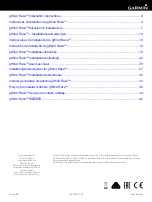
Page 54
FT
DX
1200 O
PERATING
M
ANUAL
A
B
C
I
NTERFERENCE
R
EJECTION
WIDTH
(
IF DSP B
ANDWIDTH
)
T
UNING
(
SSB/CW/RTTY/DATA M
ODES
)
The IF WI
'
TH tuning system allows you to vary the width of the
'
S
3
IF passband, to reduce or eliminate interference.
0
oreover, the bandwidth may actually be
expanded
from its default setting, should you wish to enhance incoming sig-
nal
¿
delity when interference on the band is low.
1.
5
otate the [
WIDTH
] knob to the left or right to re-
duce the interference.
A
DVICE
:
The fre
T
uency display will show the bandwidth of
the IF passband for 3 seconds whenever the [
WIDTH
]
knob is turned.
[WIDTH] Knob
5
eferring to Figure “
B
”, you can see the default
bandwidth on the SSB mode.
By rotating the [
WIDTH
] knob to the left, the
bandwidth will narrow
see Figure “
A
”, while
rotation of the [
WIDTH
] knob to the right, as
depicted in Figure “
C
”, will increase the band-
width.
A
B
C
The default bandwidths, and total bandwidth ad-
justment range, will vary according to the operat-
ing mode
SSB
0
ode
1.8 kH
]
a
4.0 kH
]
default
.4 kH
]
).
CW
0
ode
00 H
]
a
.4 kH
]
default
.4 kH
]
)
5
TTY
'$
T
$
0
odes
00 H
]
a
.4 kH
]
default
00 H
]
)
Using IF SHIFT and WIDTH Together
The IF SHIFT and Variable IF WI
'
TH features
together form a very effective interference-
¿
ght-
ing
¿
ltering system.
For example, in Figure “
A
”, you can see how
interference has appeared both on the high
and low sides of the desired signal.
5
otate the
[
WIDTH
] knob, the interference from one side
can be eliminated
Figure “
B
”).
1
ext, rotate the
[
SHIFT
] knob to re-position the passband
Figure
“
C
”), the interference on the opposite side can be
removed, without re-introducing the interference
previously eliminated in Figure “
B
”.
A
DVICE
:
For best interference reduction, the WI
'
TH and
SHIFT features are the primary tools you should
use, after narrowing the bandwidth
WI
'
TH)
and
or adjusting the center of the passband
SHIFT). The Contour control may then yield
additional signal-enhancement benefits on
the net residual bandwidth.
(
ven more, the IF
12
TCH Filter
described later) may also be
used, in conjunction with these
¿
lter systems, to
signi
¿
cant advantage.
WIDTH I
NDICATOR
IF BANDWIDTH
IF BANDWIDTH
IF BANDWIDTH
SHIFT
SHIFT
SHIFT
Desired Signal
Desired Signal
Desired Signal
QRM
QRM
QRM
QRM
QRM
QRM
IF BANDWIDTH
IF BANDWIDTH
IF BANDWIDTH
















































